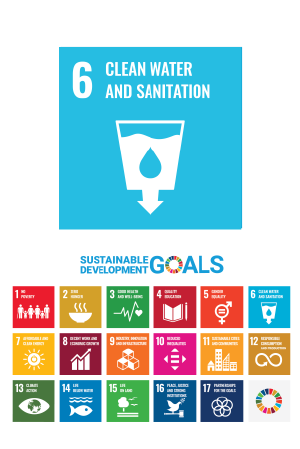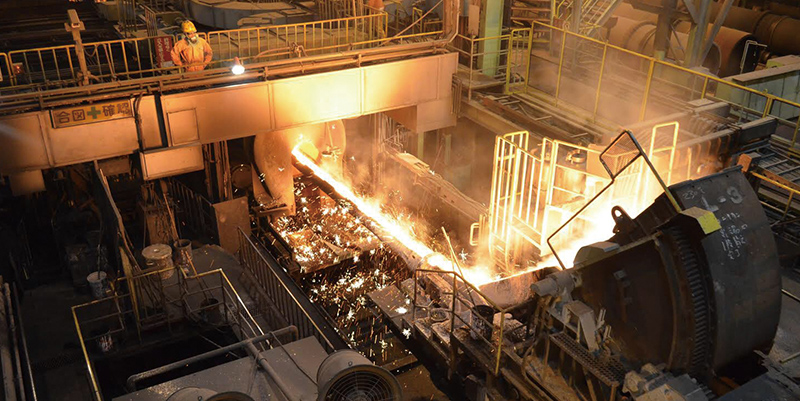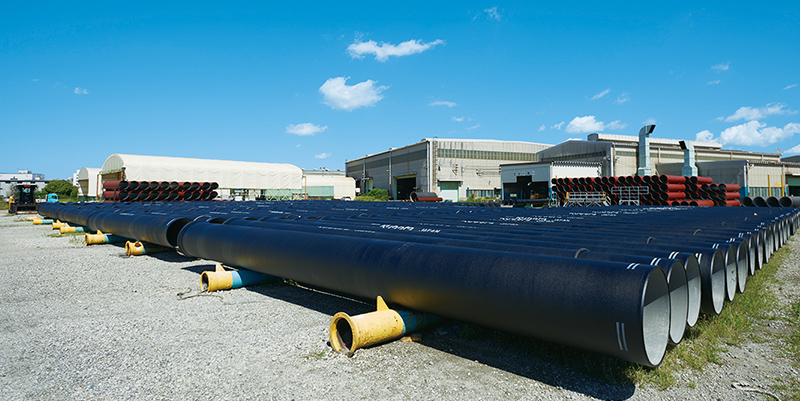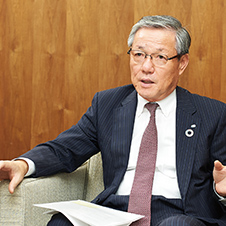01
Making a Difference in the World Through Water and Environmental
Infrastructure
- Affinity between Kubota’s founder’s aspirations and SDGs -

“Clean water and sanitation” Water resources growing harder to access

Sustainable Development Goals (SDGs) are a collection of concrete policies and actions set by the UN Sustainable Development Summit in 2015, which are outlined in the outcome document titled “Transforming our world: the 2030 Agenda for Sustainable Development (2030 Agenda).” Developed to succeed the Millennium Development Goals (MDGs), which are touted as the most successful global framework ever to combat poverty, this new Agenda contains 17 field-specific SDGs with 169 associated targets (indicators) that the 193 UN Member States will be working on over the course of the years up to 2030. SDG 6 relates to “Clean water and sanitation.” At present, the circumstances surrounding water resources continue to deteriorate around the world. Although one of the MDGs—to halve the proportion of those without access to safe drinking water between 1990 and 2015—was achieved in 2010, it was estimated that approximately 660 million people were still without access to basic water supply services as of 2015*1. Meanwhile, water demand continues to surge owing to the increasing population, economic development, and a higher standard of living. One report predicts that the global gap between existing accessible supply and 2030 water withdrawals could be as great as 40%*2. To overcome this critical situation, SDG 6 is focused on the field of water and sanitation to “ensure availability and sustainable management of water and sanitation for all.” To achieve this goal, it is vital that we develop infrastructure, provide sanitation facilities, and expedite improvement of sanitary conditions at all levels. To mitigate global water shortage, those in the international community are urged to further collaborate with each other by allocating limited water resources both efficiently and appropriately, increasing the sustainability of water use, and supporting water treatment technology in developing regions, in addition to protecting and restoring water ecosystems.
- *1.UNICEF/WHO Joint Monitoring Programme
- *2.Charting Our Water Future, 2030 Water Resources Group
-

How should we conserve precious water resources? The wisdom of humanity is being tested here. -

The founder’s aspiration of “saving people from the menace of infectious diseases” is still alive at the manufacturing site of iron pipes. (Kubota Keiyo Plant)
Japan’s first massproduced cast iron pipes for water supply Kubota’s founding business
Japan has not been without water problems in the past. The country has been challenged by all sorts of related problems, including prevalence of water-borne diseases, water restrictions due to drought, land subsidence as a result of excessive groundwater pumping, and water pollution in rivers and inland waters from domestic and industrial wastewater. Having overcome these challenges, Japan now boasts nearly 100% coverage of water supply, has managed to contain land subsidence, taken a series of measures to conserve the water environment, and is among the world’s pioneers in efficient use of water resources. Kubota’s contributions to resolve water problems in Japan during its founding days deserve special mention. Between the 1870s and the 1890s, cholera was raging through Japan, claiming many precious lives. Cholera is a water-borne illness, and the lack of a viable water supply system was partly to blame for its prevalence. Out of the strong desire to “save people from the menace of infectious diseases,” Kubota’s founder Gonshiro Kubota made the the supply of safe water a reality when he became the first in Japan to mass-produce cast iron pipes for water supply in 1893, thus paving the way to develop the modern water supply system that is still in operation now.
“Gonshiro once said, ‘Create products with all your heart and soul and realize the commodity values of such products in correct definitions,’ which ref lects his wish to produce things that are of use to society. Do whatever pleases others, solves urgent problems, or meets immediate needs, even though efforts to do so may not be spectacular or eye-catching. It was this aspiration of his that led to the creation of water pipes, engines, and farming machinery. The fact that these businesses still have a place in the market after so many years is evidence that Kubota is doing the right thing with its business.” (Toshihiro Kubo, Representative Director and Executive Vice President, Kubota Corporation)
-

Ductile iron pipes awaiting shipment, through which “water of life” is supplied to people the world over.(Kubota Keiyo Plant)
An indicator to verify achievement of SDGs Provision of cutting-edge technologies and products

Representative Director and Executive Vice President GM of Water and Environmental Infrastructure Domain Kubota Corporation
As water pollution problems surfaced in the 1960s when Japan was undergoing rapid economic development, Kubota was quick to establish the Water Treatment Business Division, which has since grown to cover a wide array of fields from water supply to sewage. Offering an unrivaled range of water-related products, including ductile iron pipes, pumps, valves, water purification systems, industrial wastewater / sewage treatment systems, and drainage systems, Kubota has played a key role in enriching the living environment for people the world over through the development of water and environmental infrastructure. More than 120 years have passed since the founder took on the challenge of domestic production of cast iron pipes for water supply. Throughout the years, Kubota has made it its mission to tackle social issues through its business. Here, one can see that Kubota’s founding objectives and the global initiative of the SDGs have much in common.
“We can safely say that more than a few of Kubota’s businesses overlap with the SDGs. I believe the success or failure of the SDGs will be determined by the organizational strength, financial strength, and human resources of the private sector. Because the SDGs seek to solve issues for all humanity in order to realize a sustainable world, I have to admit that some of their aspects may not be viable for business enterprises. From the viewpoint of the sustainability of business as well as the sustainable development of target countries, however, we believe that we should introduce state-of-the-art technologies and products, because this will help us to contribute to industrial and economic development and provide solutions to social issues in such countries over the next ten to fifty years. We believe that this is what a private enterprise can do to help achieve the SDGs.” (Kubo)